Tag: training

Bust Past Plateaus With Accommodating Resistance
Have you been stuck at the same bench press max for quite some time now? If so, you’ll need to make some adjustments to your plan to help you hit a new max. One way to help you break these plateaus you’re having if all the other things you’ve tried haven’t been working is through the use of accommodating resistance.
At some point during your lift, the lift is easier than at other points of your lift. Well, accommodating resistance ensures that the trouble-free parts of your lift remain a pain in the neck, and for good reason. Keeping the lift challenging throughout its entire range of motion will make you stronger at the weak portions of your lift, known as sticking points, which will push you past any weight you once thought you’d be stuck at ‘til eternity.
In this article, we’ll cover what accommodating resistance is, and why you should start utilizing it, like today, especially if you’ve been stuck at the same stubborn weight for some time.
What is Accommodating Resistance?
Accommodating resistance is when you add extra resistance to your lifts through the use of bands or chains to make your lift easier or more difficult during different phases of the lift. Moving weight without any accommodating resistance makes the lift less challenging at parts, however, when you add accommodating resistance, it will make the movement remain difficult through every degree of the lift.
Let’s take barbell bench press for example. If you add accommodating resistance to this lift, the movement becomes more challenging as you press the barbell up since the tension increases as the barbell moves further away from your body. Generally, this exercise gets easier as you push the barbell up, but with the added resistance, the movement maintains its challenge as the barbell moves through all ranges of motion. This will help you break past sticking points and help get you stronger at each degree of the lift, helping you get stronger and hit new personal records (PRs).
Different Accommodating Resistance
Typically, there are two common accommodating resistance lifters will use, resistance bands and chains. Below, we’ll cover the difference between them.
Resistance Bands
Resistance bands are great for adding extra tension to your lifts while accelerating the eccentric — lengthening — portion of your lift — think of the barbell bench press example mentioned above. When you use accommodating resistance bands, while the bands make the lift harder as your barbell is pressed up, the resistance bands go down faster during the eccentric portion of the lift (as the barbell is lowered). This will help you increase your lifting speed, which will improve your strength and power. Think of a rubber band; they act like a rubber band and help make the object it’s pulling easier during the downward phase, but more challenging during the upward phase.
Accommodating resistance bands are also great to utilize for beginners during bodyweight movements who haven’t yet developed enough upper body strength to do pull-ups or chin-ups. The accommodating resistance band will help reduce the lifters’ deadweight and support them throughout the eccentric and concentric — muscles shorten — phase of the exercise.
Chains
Another common modality for using accommodating resistance is chains. Chains don’t help the eccentric portion of your lifts since it doesn’t have the “rubber band effect.” They’re more similar to adding extra weight to your barbell, similar to weight plates, and will also make movements more challenging as the chains lengthen.
Why Use Accommodating Resistance?
Now you know a couple of reasons why it may be a good idea to start utilizing accommodating resistance during your workouts, but let’s cover the benefits in more detail below.
Break Past Sticking Points
As mentioned above, sticking points are the weak portion of your lift; the part of the lift that is most challenging for you to punch through. For example, a common sticking point many lifters experience during the barbell squat is at the bottom of the movement. The problem is that the bottom position of the squat — the hole —, is the most difficult portion of the lift, and it gets progressively easier as you bring the weight up. However, accommodating resistance will ensure that the lift remains challenging as you bring the weight up, which can help you increase your total squat strength since the lift will be heavy at each degree of the lift instead of being lighter when you bring the weight up as it typically would be without the accommodating resistance.
Bigger Muscles
Bigger muscles are another benefit you get to look forward to with the help of accommodating resistance. Of course, if you’re able to add more resistance to the weight you’re normally used to doing and are doing the same reps, then your muscles will grow. A big proponent to accommodating resistance, though, is that it doesn’t only add more resistance to the weight you’re using, but it makes the weight more challenging through all ranges of the lift, which as we covered, will strengthen your sticking points and get your body used to heavier loads at easier points in the lift; as a result, your muscles will grow bigger.
New Personal Records (PRs)
And since you’ll be able to break through the sticking points, add weight/tension to lifts, and make each degree of the lift difficult through its full range of motion, you can only imagine what that would do to your PRs; your squat, bench press and deadlift will all increase. So if you’ve been struggling to hit new PRs no matter how much you make tweets to your training program, try accommodating resistance for a few weeks on the lifts you’re struggling with.
This study found that collegiate athletes that trained with resistance bands had higher increases in power, torque, and one-rep maxes compared to using free weights alone. (1)
Another study of D1 collegiate athletes demonstrated similar feedback showing that accommodating resistance bands improve your maximal strength substantially. (2)
Final Word
If you’ve been struggling to break new PRs in the gym on key movements like squats, deadlifts, and bench press, you’ll want to try incorporating accommodating resistance. Accommodating resistance through the use of chains or resistance bands will help you break past sticking points and make the movement more arduous through its full range of motion, making you bust through the PRs you’d never thought you’d break.
Have you tried training with accommodating resistance before? Let us know in the comments section and follow us on Instagram, Facebook, and Twitter.
Reference
1 – Shoepe, T. C., Ramirez, D. A., Rovetti, R. J., Kohler, D. R., & Almstedt, H. C. (2011). The Effects of 24 weeks of Resistance Training with Simultaneous Elastic and Free Weight Loading on Muscular Performance of Novice Lifters. Journal of human kinetics, 29, 93–106. https://doi.org/10.2478/v10078-011-0043-8
2 – Rhea, Matthew & Kenn, Joseph & Dermody, Bryan. (2009). Alterations in Speed of Squat Movement and the Use of Accommodated Resistance Among College Athletes Training for Power. Journal of strength and conditioning research / National Strength & Conditioning Association. 23. 2645-50. 10.1519/JSC.0b013e3181b3e1b6.
This 1000-Rep Arm Workout Will Add 2-Inches To Your Arms
“I should stop training my arms” – said no one ever.
If you are anything like most lifters, you love training your arms. A devout Roelly Winklaar fan, you start thinking about your next week’s bicep workout while performing the last set of dumbbell bicep curls.
Even though people love training their pythons, how many of them do you think are content with their progress? One of the reasons why people train their arms so often is that they are not satisfied with their workouts.
Most of the time, the problem is not with the lifter’s intent or performance but is with the workout routine itself.
If you cannot resist flexing your guns in car windows as you walk past them, have hit a plateau, or want to spice up your training, the 1000-rep arm workout is for you.
Introduction To The 1000-Rep Arm Workout
1. The 1000-rep arm workout is pretty straightforward and doesn’t contain any technical mumbo jumbo.
2. You will be doing five sets of 20 reps for five bicep and tricep exercises each, equaling 1000 reps total.
3. For the best result, strictly stick to the prescribed exercises, sets, reps, and rest periods.
4. The 1000-rep arm workout can be longer as compared to your vanilla workouts. Plan your gym sessions accordingly.
5. Since the 1000-rep arm workout employs extreme volume and intensity, you should not perform it every week. Start by following this program every alternating week and then switch to performing it once every three or four weeks.
The 1000-Rep Arm Workout From Hell
1. EZ Bar Curl – 5 Sets 20 Reps
The 1000-rep arm workout will take a toll on your joints, and the EZ bar can make your life a little easier. Before you begin training, perform at least a couple of warm-up sets with lighter weights.
Steps:
Stand upright while holding an EZ bar with a narrower-than shoulder-width grip.
As you breathe in, curl the barbell by bending at your elbows until your lower arms are perpendicular to the floor.
Make sure you are not using momentum to lift the weights.
Slowly return to the starting position and repeat for recommended reps.
2. Straight Bar Pushdown – 5 Sets 20 Reps
Alternate between bicep and tricep exercises so that your muscles are getting enough rest between sets.
Steps:
Stand facing a cable pulley machine with a shoulder-wide feet placement.
Set the pulley at the highest position.
Grab the straight bar attachment with an overhand grip.
Pin your elbows to your side as you push down the bar until your lower arms are perpendicular to the floor.
Return to the starting position and repeat.
3. Cable Curl – 5 Sets 20 Reps
You need to contract your biceps and triceps with every rep if you want to get the most bang for your buck. Going through the motions for the sake of it is not going to get your results. Establish a mind-muscle connection with your arms and squeeze the life out of them with every rep.
Steps:
Stand upright with a shoulder-wide stance while facing a cable pulley machine attached at the lowest setting.
Grab an EZ bar with an underhand grip.
Curl the bar while having your elbows glued to your sides.
Return and repeat.
4. Overhead Cable Extension (Rope Attachment) – 5 Sets 20 Reps
Since this is a high-intensity workout, don’t worry about following a rep tempo or going slow. Pump out the recommended repetitions with a decent speed, and let the intensity do its magic.
Steps:
Set the pulley at the highest adjustment.
Grab the rope attachment and face away from the machine.
Bend over at your waist until your torso is at a 60-degree angle with the floor.
Extend your arms straight and contract your triceps at the top of the movement.
Return to the starting position and repeat.
5. Double-Arm Dumbbell Hammer Curl – 5 Sets 20 Reps
As fatigue starts to kick in, feel free to lighten the weights but do not compromise on form and intensity. If you don’t feel a pump after 20 reps, it’s a sign that you need to lighten the weights and focus on contracting your muscles.
Steps:
While standing with a shoulder-wide stance, grab a dumbbell in each hand with a neutral grip (palms facing each other).
Keep your elbows at your sides and curl the dumbbells towards your shoulders.
Pause and squeeze the life out of your pythons at the top of the lift.
Do both arms at the same time.
6. Lying Extension With Rope Attachment – 5 Sets 20 Reps
Steps:
Place a flat bench beside a cable pulley attached to the lowest setting.
Lie down with your back placed on the bench and your head next to the pulley.
Grab the ropes with both hands and perform a skull-crusher type movement.
Don’t let your elbows flare out as you perform the exercise.
7. Seated Barbell Curl – 5 Sets 20 Reps
Steps:
Sit on a flat bench and place a flat barbell on your thighs.
Grab the bar with a shoulder-width grip.
Curl the weights from the top of your thighs towards your shoulders.
Return to the starting position with a slow and controlled motion.
This exercise works on your bicep peaks.
8. Double-Arm Dumbbell Kickback – 5 Sets 20 Reps
Steps:
Stand upright with a shoulder-wide stance and grab a dumbbell in each hand with a neutral grip.
Bend over at your lower back until your torso is at a 60-degree angle with the floor.
Lift your elbows until they are slightly above your torso. Bring the dumbbells close to your chest.
With your elbows pinned at this position, extend your arms straight.
Contract your triceps at the top of the movement.
Return to the starting position and repeat.
9. EZ Bar Reverse Curl – 5 Sets 20 Reps
Steps:
Stand upright while facing a cable pulley attached at the highest setting.
Grab the EZ bar attachment with an overhand grip.
With your elbows pinned to your sides, curl the bar by bending at your elbows.
Contract your biceps at the bottom of the movement.
10. Bench Dip – 5 Sets 20 Reps
Steps:
Place two flat benches parallel to each other.
Sit down on a bench and place your hands next to your thighs.
Place the balls of your feet on the second bench.
Hinging at the elbow, lower your body down as far as you can, or until your upper arms are parallel to the floor.
Extend your arms straight to get back to the starting position.
Rest – 2 Minutes
After every set, make sure you are not resting for more than 120 seconds. Two minutes are all you need for catching your breath and ATP replenishment. By the end of the workout, you will be running on fumes, and you will have the most insane sleeve-ripping arm pump.
Conclusion
The 1000-rep arm workout routine will train your guns from every angle. It will help break plateaus and ensure overall arm development. While we recommend following the exercises mentioned in the article, you could use substitutes or perform your favorite lifts, given they target the muscles in the same way.
In the weeks where you will not be performing the 1000-rep arm workout, you can follow your usual (read: vanilla) bicep and tricep training routines.
How often do you train your arms?
Let us know in the comments below. Also, be sure to follow Generation Iron on Facebook, Twitter, and Instagram.
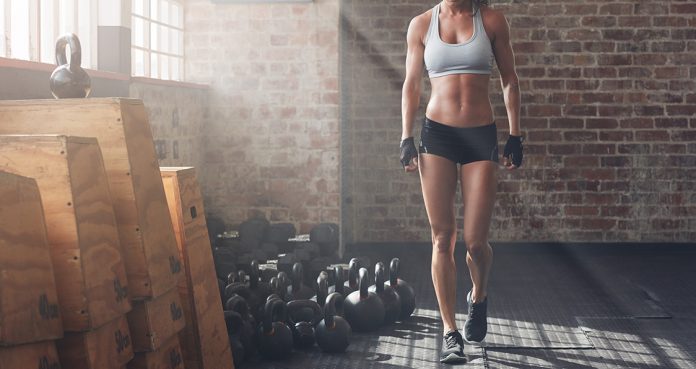
The Only Rules You Should Break In The Gym, You Won’t Believe Number 3
The Gym Rules You Need To Break To Take Your Gains To The Next Level
As cliché as it might sound, the rules are meant to be broken. The gym isn’t one of the safest places to be in so you need to be careful about the rules you’re going to be challenging.
If your goal is to live the fit lifestyle, you need to design your training keeping longevity in mind. We have compiled a list of so-called rules you should break to maximize your results in the gym while minimizing the risk of an injury.
Never Train To Failure
It’s no secret people love to throw around fancy words to look smart. Gym bros emphasis the fact you shouldn’t work out to failure as you might risk overtraining your muscles. Overtraining is easier said than done.
Overtraining is the state when your body can’t keep up with your workouts, and your immune system and central nervous system take a hit. Only around 2-5% of the people who workout train hard enough to hit the state of overtraining. So, don’t limit yourself and go as hard as you can in your workouts.
Avoid Cardio While Bulking
Most people make the mistake of cutting out cardio from their routines when they’re in their off-season and want to bulk up. Some of these people mistake bulking up with fattening up.
Cardio is important no matter if you’re trying to shed the extra kilos or trying to put on some size. The cardio helps in burning off the extra calories and makes sure you’re putting on quality muscle and not fat.
Perform High Number of Reps For Conditioning and Low Reps For Strength
High reps for cutting and a low number of reps for strength have to be one of the most common myths amongst lifters. Tweaking the number of repetitions you perform in a workout can’t solely change your body.
The results from the number of reps don’t work in a vacuum. Other things like your diet, training split, and the amount of cardio you’re doing will play a big role in the results you’ll be getting. Changing the number of reps can act as a shock for your muscles but it solely isn’t big enough a change for your muscles to show any significant results.
Prefer Free Weights Over Machines
This is one of the first things the gym bros tell the newbies. The gym bros argue the golden era athletes built their physiques in bare bone gyms and the fancy machines don’t help in carving an aesthetic body.
Avoiding the machines can be a big mistake as the isolation you’ll get by using the cables and pulleys will always be better than using barbells or dumbbells. Your workouts should strike the right balance between isolation and compound lifts.
Always Use A Full Range of Motion
Almost everyone, at some point in time, has been disturbed in-between a set by a gym bro asking you to perform the exercise with a full range of motion. The gym bros tell you that if you don’t follow a full ROM, you’ll not be getting any results.
On the contrary, when you follow a full ROM and lockout your elbows on the top and let your muscles relax on the bottom of the movement, you’re taking the tension off the muscles and putting it on the joints. It’s okay to limit your range of motion so there is constant tension on your muscles.
Have you ever been injured in the gym?
Let us know in the comments below. Also, be sure to follow Generation Iron on Facebook, Twitter, and Instagram.
Header image courtesy of Envato Elements
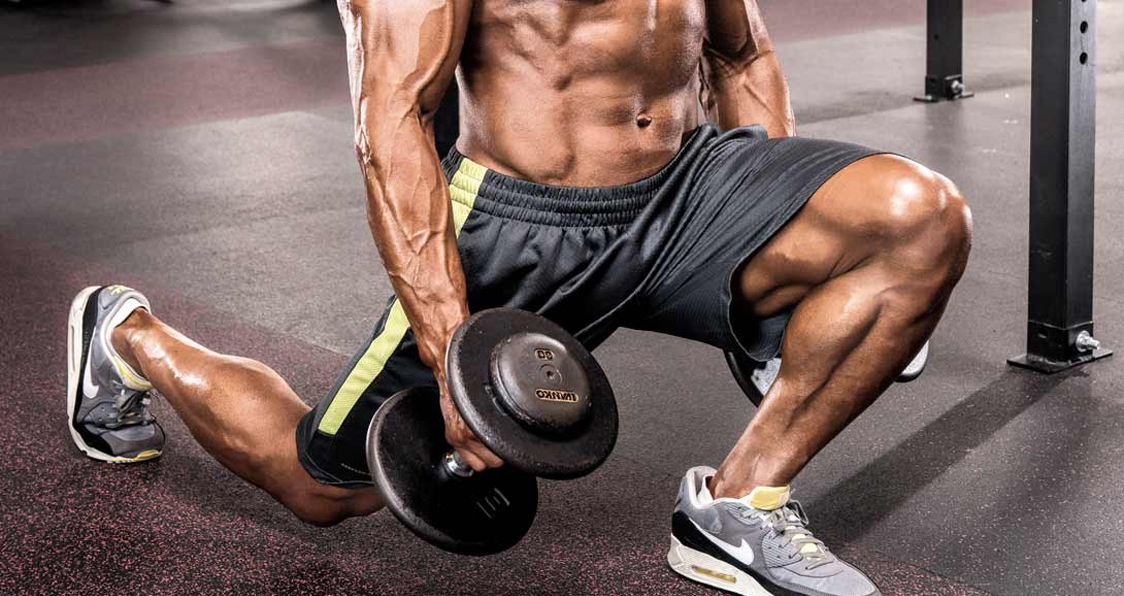
Build Shredded Legs With This Dumbbell Workout
There can be many reasons why people don’t want to use a barbell. It could be because of a back pain or your general dislike for the barbell that you want to stay away from it. It is said compound movements with a barbell are the best way to build big legs.
This is complete BS! Your muscles have no idea if you’re using a barbell or dumbbells. All they know is if you have trained them to failure. You can completely eliminate barbells and other machines from your leg workouts and still build monster wheels.
1. Goblet Squats – 3 Sets 15 Reps
Goblet squats can be a life saver if you’re suffering from a back injury. This exercise forces you to keep your back straight and hence eliminates all the tension from it. Goblet squats target your quads and will leave you limping by the time you’re done with this exercise.
Stand with your feet slightly wider than shoulders width apart. Hold a dumbbell in front of your chest with both your hands. Perform a squat until your hams touch your calves. Keep your back straight, and head and chest up.
2. Dumbbell Lunges – 3 Sets 15 Reps On Each Leg
The range of motion is the key while performing this exercise. Most people make the mistake of placing their feet way too far apart or way too close to each other. Use weights with which you can complete 30 reps in one set.
Your front knee should not extend farther than your big toe and the quad of the second leg should be parallel to the calf of the front leg while you’re at the bottom of the movement. This is the optimal position to perform dumbbell lunges.
3. Dumbbell Romanian Deadlifts – 3 Sets 10 Reps
Dumbbell Romanian deadlifts are one of the best exercises to target your hams. Using dumbbells instead of a barbell will help you increase your range of motion. Barbells can limit your motion by making you follow a straight line of movement.
Using dumbbells lets your arms free and you can follow a movement where you have the greatest amount of tension on your quads. Most people complain about lower back recruitment while using a barbell, this problem is eliminated when you use dumbbells.
4. Dumbbell Step Ups – 3 Sets 12 Reps On Each Leg
Dumbbell step ups are a complete leg buster. This exercise will set your quads on fire. If you don’t have access to an elevated platform at your gym, you can use a flat bench for this exercise.
Stand while facing the platform with dumbbells at your sides. Step onto the platform with your right foot, extend your right leg and hip at the top of the movement. Place your left foot on the platform as well. Step down with your left foot and repeat with the right leg.
5. Dumbbell One-Legged Deadlifts – 3 Sets 12 Reps On Each Leg
Dumbbell one-legged deadlifts are a unilateral exercise. Unilateral exercises are the ones which work one side of your body at a time. This can help with developing the muscles and strength on your weaker side.
One-legged deadlifts help with isolating the hamstring and establishing a mind-muscle connection. Hamstrings can be a hard muscle group to train and develop as you can’t see them in the mirror and hence it becomes harder to develop a connection with them.
Have you ever tried a dumbbells only leg workout?
Let us know in the comments below. Also, be sure to follow Generation Iron on Facebook and Twitter.

Avoid These 5 Dieting Mistakes To Make Progress
5 Most Common Dieting Mistakes
It’s no secret that following the right diet is the key to losing weight or gaining muscle mass. Designing the right diet is like solving the matrix for most people, and they give up without trying.
Most of the people who do start a diet, give up soon after they don’t see any results. Almost all diets fail because of a few fundamental problems. If you avoid the common mistakes, you’ll be on your way to making serious progress.
Cutting Out The Fats Completely
When some people start a diet plan, they take fats to be the villain and design their diets to exclude the macronutrient from their diet completely. Removing fats from their diet is a big reason most people don’t see any results while dieting.
Fats are an essential macronutrient and play a vital role in joint and bone support along with maintaining an energy reserve in the form of fat which can be used by the body in times of emergency. Not consuming the proper amount of fats in your diet forces your body to store fat and can lead to joint pains and other functioning issues.
Not Doing Cardio
While following a customized diet plan for reducing fat or building muscle will start working on its own, you’ll need to add cardio to the mix to fasten up the process especially if your goal is weight loss.
Adding cardio to your training routine is a great way of maintaining a calorie deficit which will help you shed the extra kilos, and reduce the body fat percentage. You should consider adding a 10-minute session of HIIT cardio to your program.
Misunderstanding Carbs
After fats, carbohydrates are considered to be the enemies of fat loss by some people. Many of the rookies try to bring down their daily carb intake into double digits unknowing it’s going to do more harm than good.
As a rule of thumb, you shouldn’t drop down your daily carb consumption below 1g per pound of bodyweight until you’re in the final weeks leading up to a competition. If you’re reading this article, chances are you’re not going to step on stage anytime soon.
Becoming Way Too Strict
Many people get too strict and serious about their diets when they start out. They cut out all the fats and carbs from their diet and stick to a narrow and incomplete diet. These people eventually burn out and quit the fit lifestyle.
When you’re starting out, you need to follow a rational approach and gradually add or subtract from your diet. Cutting out your normal food too fast can make you feel drained out and you might end up deciding this lifestyle is not for you.
Jumping Ships
Some people get disheartened when they don’t see the results they were hoping to see. Thanks to the advancement in the dietary space, there are many different diets to follow and people sometimes get spoilt for choice.
When some people don’t see results, they end up deciding that the diet they are currently following isn’t suiting them and switch to a new diet. You need to give your body time to adjust to a diet so you can see results.
How many different diets do you know about? Let us know in the comments below. Also, be sure to follow Generation Iron on Facebook, Twitter, and Instagram.
Header image courtesy of Envato Elements
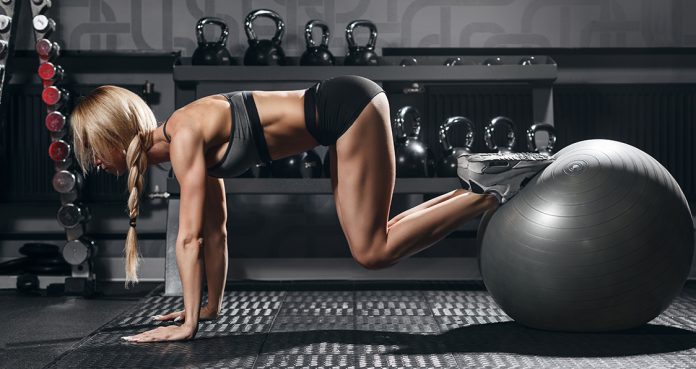
Read This To Make Continuous Progress in The Gym
Make Constant Progress With These Tips
If you have been working out for some time, chances are you know what it feels like to hit a plateau. Hitting a plateau is the feeling you get when you’re hurdling but in place of a hurdle, there’s a wall, and no matter how fast you run, you can’t pass through it.
Making constant progress year-on-year is something everyone wants but only a few get. In this article, we’ll be sharing the tricks the pros use to make continuous improvements and avoid hitting roadblocks.
Keep Challenging Your Body
You aren’t going to keep improving until you keep challenging your muscles. Every time you’re in the gym, do something to shock your body. Lift heavier weights than you did the last time, try a new training technique or triple the number of reps you usually perform.
Once your muscles get used to your way of training, it’s game over for you. A good rule of thumb should be, if you’re comfortable in the gym, you’re doing it wrong. If you follow some of the pros on social media, you’ll see them taking their bodies through grueling workouts, and that is the secret to their success.
Keep Your Recovery On Point
Most people make the mistake of underplaying the importance of recovery in their transformation. They think the only thing that matters for muscle building is how hard they train.
It may come as a surprise to some people, but the role of the right diet and recovery combined form a bigger part in a body transformation as compared to training alone. Make sure your nutrition plan and recovery schedule is in line with your goals.
Shake Up Your Routine
Following the same routine day in and day out can become monotonous. Nothing exciting comes your way if you’re leading a boring life. You need to shake things up constantly to see constant progress.
If you have been following the same diet for a long time, it might be time to try something new. Switching to a new gym or finding yourself a new training partner or a coach can be enough to spark new growth.
Expand Your Knowledge
With the advancement in research in fitness, new things are being discovered constantly. Keeping yourself updated with the developments in the sport can help keep your progress graph pointing upwards.
The more you learn, the better understanding you’ll have of things you’re doing, and ways to make them more effective. Also, knowledge is what separates the pros from the gym bros.
Take A Break
Sometimes when people are stuck in a plateau, they try to push themselves harder in the gym which can do more harm than good. Overtraining is one of the most talked-about and yet misunderstood concepts in fitness.
Overtraining can take a toll on your central nervous system (CNS) and impair your body’s ability to make progress. If you’re not successful in breaking through the overhead ceiling, it might be better to take a break and give your body time to recover.
Have you ever been injured in the gym? Let us know in the comments below. Also, be sure to follow Generation Iron on Facebook, Twitter, and Instagram.
*Header image courtesy of Envato Elements
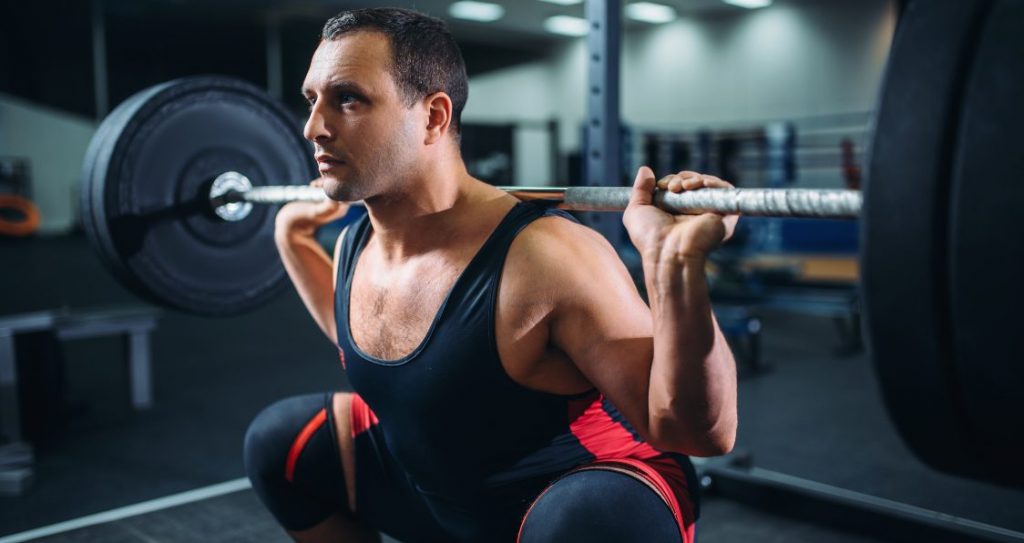
The Differences Between the Back Squat Vs. Front Squat Explained
Many tout the barbell back squat to be the king of all exercises and while the back squat does have a lot of benefits, so does its squat-brother, the barbell front squat. Both movements build strength and hypertrophy in your lower body — glutes, quads, and hamstrings —, although each one emphasizes more of your anterior (front) or posterior (back) muscles.
Depending on if you have lower back pain, are an athlete, new to the gym, or what your goal is will determine what movement you should focus on. This article will cover the form differences of each, what muscle they work, and which one to do.
What Muscles Do They Work?
The back squat and front squat both work your lower body muscles — glutes, hamstrings, and quads —; however, each one activates one more than the other.
Posterior Chain Vs. Anterior Chain
The back squat will work more of your posterior chain — glutes and hamstrings — while the front squat will engage more of your anterior chain — quadriceps. That’s because when you do a back squat you load the barbell behind your midline, and when you do a front squat, the load is placed in the front — where your quads sit.
How to Do the Back Squat
Place the height of the squat rack clips to a height that allows you to comfortably rest the barbell on your back and unrack the weight without having to squat down too low or get on your tippy-toes to lift the weight up — you should be in a quarter squat position. Grab the barbell with your hands, lift the weight, then slowly take a few steps back — this is your starting position. Now, squat down to make your legs form a 90-degree angle or slightly past that while keeping your torso upright, then extend up. Make sure that you stay back on your heels and keep your knees as stable as possible through the full range of motion.
Benefits
You can use more weight than most movements.
It works your posterior chain.
Easier to do for beginners than front squats.
How to Do the Front Squat
Place the height of the squat rack clips to a height that allows you to comfortably rest the barbell on your upper chest and unrack the weight without having to squat down too low or get on your tippy-toes to lift the weight up — you should be in a quarter squat position. Grab the barbell with your hands with a close grip and lift the weight up and take a couple of steps back to get into the starting position. Squat down to make your legs parallel with the ground — where your knees meet your thighs — or slightly past that, then lift the weight up. It’s important you keep your torso straight and don’t allow your knees to go over your toes during the eccentric (lengthening) and concentric (contraction) portions of the lift.
Benefits
Targets your anterior chain with a heavy load.
Healthier for your back than the back squat.
Differences Between the Back Squat and Front Squat
Each brother-squat has their distinct technique difference, as well as different benefits. Below, we’ll be covering those, so you get a better idea of which one would benefit you the most.
Barbell Positioning
The major difference between the front squat and back squat is where the barbell sits, of course. The barbell rests on the top of your back on the barbell squat while it rests on your upper chest for the front squat.
Wrist Mobility
With the front squat, you’ll need good wrist mobility to rest the barbell onto your upper chest. However, if the movement feels a bit uncomfortable, you can opt to cross your arms and grasp the barbell on each side while the barbell rests on your collar bone.
Total Strength
Overall, you’ll be able to use more weight with barbell squats than you will with front squats. That’s because it’s easier to lift a load on your back than it is on your chest since you’ll be activating your glutes and hamstrings more, which are stronger than your quads alone.
Knee and Back Health
The front squat places less stress on your spine and knees than the barbell squat does, so it’s healthier for your back. (1)
Similarities Between the Back Squat and Front Squat
Although the back squat and front squat are different, many parts of their movement and benefits are the same. Read on to learn their similarities.
Squat Form
Though both squat variations have their differences, the correct form of a standard squat applies to both. You’ll be in a shoulder-width stance and squat down to parallel or slightly past that. You’ll also keep your back straight and your torso upright while keeping your front knees behind your toes when you squat down. Also, both require you to keep your knees stable without valgus (knees caving in) or varus (knees pointing out).
Muscles Worked
Although the back squat and front squat split the emphasis each will place on your different lower body musculature, both barbell movements will engage all the muscles in your lower body.
When to Use Each
After learning the similarities and differences between both squats, deciding which one is right for you can still be confusing. Below, we’ve garnered a list to help make that choice a breeze.
Back Issues
If you have any back issues, it’s best to stick with front squats since you won’t be placing as much load on your spine.
Athletes
Athletes that require sprinting and jumping should focus more on back squats since your glutes and hamstrings are used more than your quadriceps during those movements. (2)
Beginners
Beginners should focus on back squats and get that form down before transitioning to front squats since it doesn’t require as much mobility.
Occupation
If you have a desk job, you’ll likely be quad dominant and be at an increased risk for tight glutes, which can lead to lower back pain; therefore, it’s recommended that you stick with back squats since it activates more of your glutes.
Strength and Power
For overall lower body strength and power, you’ll want to do back squats since you’ll be able to load the barbell with more weight.
Final Word
The barbell squat and front squat are both exceptional movements for building strength and hypertrophy in your lower body. The back squat will allow you to use more weight and focus more on your posterior chain, but the front squat is healthier for your back and will strengthen your quads more.
Follow us on Facebook, Instagram, and Twitter for more lifting tips!
References
Yavuz, H. U., Erdağ, D., Amca, A. M., & Aritan, S. (2015). Kinematic and EMG activities during front and back squat variations in maximum loads. Journal of sports sciences, 33(10), 1058–1066. https://doi.org/10.1080/02640414.2014.984240
2. Myer, G. D., Kushner, A. M., Brent, J. L., Schoenfeld, B. J., Hugentobler, J., Lloyd, R. S., Vermeil, A., Chu, D. A., Harbin, J., & McGill, S. M. (2014). The back squat: A proposed assessment of functional deficits and technical factors that limit performance. Strength and conditioning journal, 36(6), 4–27. https://doi.org/10.1519/SSC.0000000000000103
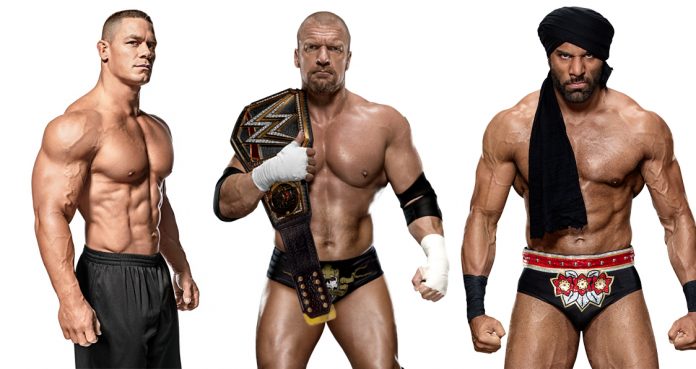
These are the Most Ripped WWE Superstars
Ripped to the bones WWE Superstars
WWE is one of the most well-recognized entertainment brands in the world. The WWE athletes go above and beyond to entertain the franchise viewers. Most of the stunts which the WWE athletes perform need them to be in the best physical condition.
The WWE superstars spend countless hours in the weight room training for their fights. Some of the superstars have peak muscle conditioning and can give the pro bodybuilders a run for their money.
Triple H
Triple H is a WWE veteran and has been around the wrestling scene for a long time. Paul ‘Triple H’ Levesque has been in shape since the starting of his career and shows no signs of slowing down.
John Cena
Cena arguably has one of the biggest following in the WWE. John takes his fitness seriously and has his own gym. Before joining WWE and all the fame, Cena was a trainer at the Gold’s Gym, Venice beach.
Sheamus
Sheamus has earned a name for himself for being a ruthless competitor. The Celtic warrior has muscle mass and definition which could put many bodybuilders to shame. Sheamus has a well proportionate physique and would score well if he stepped onto a bodybuilding stage.
Cesaro
Joining Sheamus on this list is his current tag team partner, Cesaro. Cesaro is probably pound-for-pound the strongest man in the WWE. Follow him on Instagram to see him move some heavyweights.
Jinder Mahal
Jinder Mahal has quickly risen ranks from being a jobber at Raw to being the WWE champion on SmackDown. Mahal’s talent and stunning physique set him apart from his competition.
Scott Steiner
Scott Steiner aka Big Poppa Pump is one of the first WWE athletes to have a ripped physique. Steiner was famous for his peaking biceps and a chiseled upper body. Scott confirmed that women love men with big muscles.
The Rock
The Rock is probably the most celebrated WWE superstar. Dwayne “The Rock” Johnson has gone through many transformations in the recent years. The Rock’s new transformation is always better than the previous one. The Rock is known to have one of the most intense work ethics.
Batista
Batista dominates the WWE ring every time he walks into it. Batista earned the name “The Animal” for his relentless intensity inside the squared circle. Batista has since moved into Hollywood and features in films like Guardians of the Galaxy, Spectre, etc.
The Ultimate Warrior
The Ultimate Warrior was ripped before it was in trend. The electrifying presence of the Ultimate Warrior and a chiseled physique made him a crowd favorite. James Hellwig aka The Ultimate Warrior passed away soon after giving a heartfelt WWE hall of fame induction speech.
Who is your favorite WWE superstar?
Let us know in the comments below. Also, be sure to follow Generation Iron on Facebook and Twitter.
*Images courtesy of Instagram
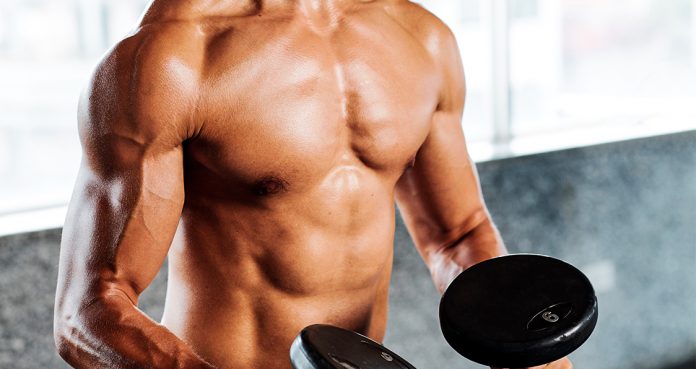
This is How You’re Stopping Yourself From Building Muscle
Avoid These Things to Build Muscle Mass
Going to the gym six days a week doesn’t guarantee you’ll build muscle mass. Without even knowing it, you might be doing a few things which could be acting as hurdles between you and your dream physique.
You build muscle when you do a series of right things. Going out of line in a single aspect can negatively affect your gains. In this article, we’ll be listing out five ways you could be stopping yourself from building muscle.
Lack of Recovery
Some people wear the “4-hour sleep a night” tag with pride. If your goal is to build muscle mass, you can’t afford to have anywhere less than seven hours of sleep every night. Your body recovers and puts on muscle size while you’re in deep sleep.
If you face sore muscles too often and can’t seem to recover from your workouts, you should consider using supplements to aid your recovery. Massages, stretching, Epsom salt baths are other effective recovery methods.
Generic Diet Plan
Following a custom diet plan is indispensable when it comes to building muscle mass. You can’t solely rely on making the right decisions when it comes to your daily meals. You should design a diet plan while keeping your daily calorie and macros goals in mind.
Getting professional help if you can’t build your diet plan can save you a lot of effort and time. For your diet plan to be sustainable, make sure it fits into your lifestyle so that you don’t have to make big sacrifices and adjustments to follow it.
Overtraining
When people don’t see results, they push harder, and it might do more harm than good. Overtraining can take a toll on your CNS (central nervous system) and can hamper your immune system.
If you take too long to recover from your workouts, chances are you might be in an overtrained state. Stopping training will be your best bet in situations like these until you get back on track.
Not Following A Customized Workout Plan
Most people take their workout programs too lightly and are happy following the free workout plans they can find online. You need to remember that no two people have the same genetics or muscle maturity.
Everyone has their strengths and weakness, and you need to device a workout program which works on building your weaker muscle group and polishes your strengths. Getting a customized diet plan will pay dividends in the long run.
Alcohol
If you’re on a timeline, drinking alcohol can act as a setback. As soon as you have a glass of your favorite poison, your body treats it just like that, a glass of poison. On alcohol consumption, your body slows down your metabolism and ramps up the fat storage in your body.
Alcohol is a source of empty calories and does nothing more than add layers of fat on your body. So, if you want to do a transformation, you might want to take your drinking down a notch or two.
Are you committing any of these sins? Let us know in the comments below. Also, be sure to follow Generation Iron on Facebook, Twitter, and Instagram.
Header image courtesy of Envato Elements
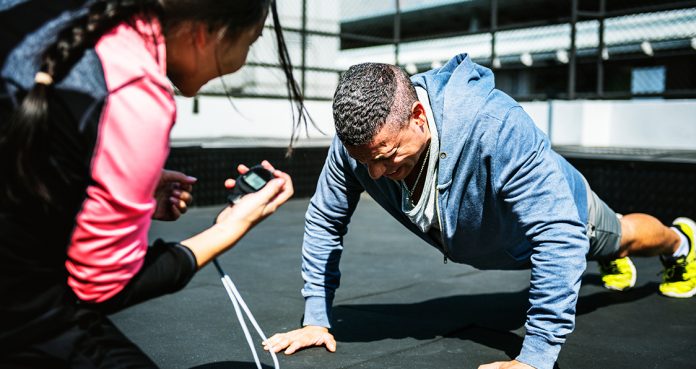
These Are The Guaranteed Ways of Overcoming Your Training Plateau
Ways of Breaking A Training Plateau
Hitting a training plateau can be one of the most frustrating things. You know you’ve hit an overhead ceiling when you can’t seem to make gains no matter what you do in the gym. Hitting a plateau is not something unusual and you might be suffering from it without knowing it.
There is nothing wrong with hitting a plateau but staying on it can be disastrous for your physical and mental health. There are a few things you can do to overcome the gain roadblocks when you hit them.
Change Your Training Program
Following the same training program for a long time can cause you to hit a plateau. You need to constantly add variations to your workouts to avoid hitting a muscle growth roadblock.
You should try changing or making adjustments to your workout program every 8-12 weeks. Starting a new program or following a new training philosophy can re-ignite your muscle growth.
Fix Your Diet
A nutrition deficient diet can be one of the leading causes for hitting a training plateau. Figure out your daily caloric requirement according to your training goals and design your diet keeping your macro and micronutrients in mind.
You could also use the help of supplements to fill the gaps in your nutrition. Make sure you don’t overly rely on supplements and keep real food as the main source of your nutrition. If you don’t know how to design your own diet, getting professional help can save you a lot of time and wasted effort in the gym.
Step Off The Gas
When people realize they have hit the gains roof, they train harder. Training harder than before can be a vicious cycle if you’re on a plateau. Maybe training too hard and a lack of recovery is what got you there in the first place.
Analyze your recovery plan and check if there are any loopholes. You should be getting anywhere between 6-8 hours of sleep every night to streamline the recovery from your workouts. Check if you’re sore for too long after your workouts. Being sore for a long time can be a sign of overtraining.
Shock Your Muscles in Every Workout
Your muscles are quick to adapt to your style of training and you need to constantly shock your muscles into growing. Do something new in every workout so your muscles have no idea what hit them.
Use an advanced training technique like supersets, drop sets, etc. or go crazy by doing 30-50 reps on your last set of every exercise. Using equipment like fat grips, arm blaster, new kinds of bars is also an incredibly effective way of adding variation to your training.
Stop Training Completely
If you can’t seem to make any progress after tweaking your training and diet, chances are you are overtraining. You should consider stopping working out and give your CNS (central nervous system) some time to recover.
Although stopping training can seem counter-intuitive but gaining muscle mass or losing weight will be easy once you come back from the break. Consider the break as a gym-detox for your body.
Have you ever hit a training plateau? Let us know in the comments below. Also, be sure to follow Generation Iron on Facebook, Twitter, and Instagram.
Header image courtesy of Envato Elements
